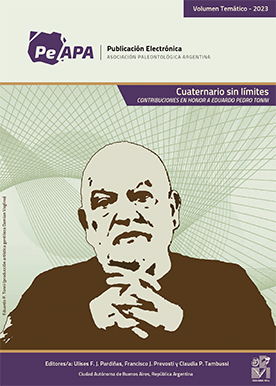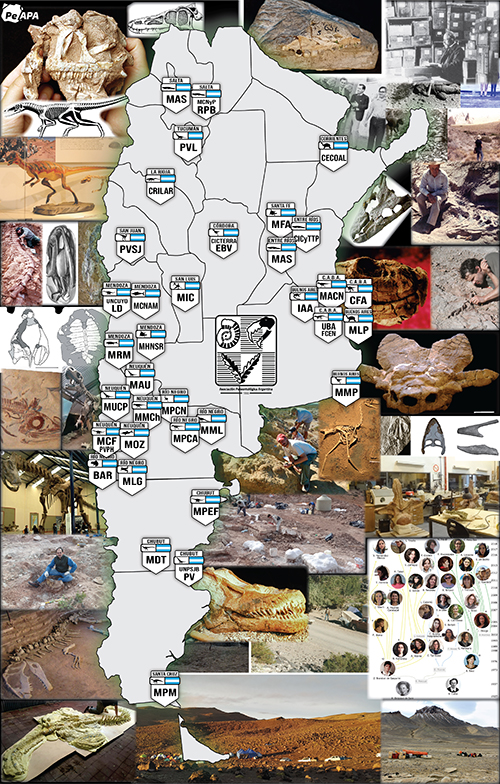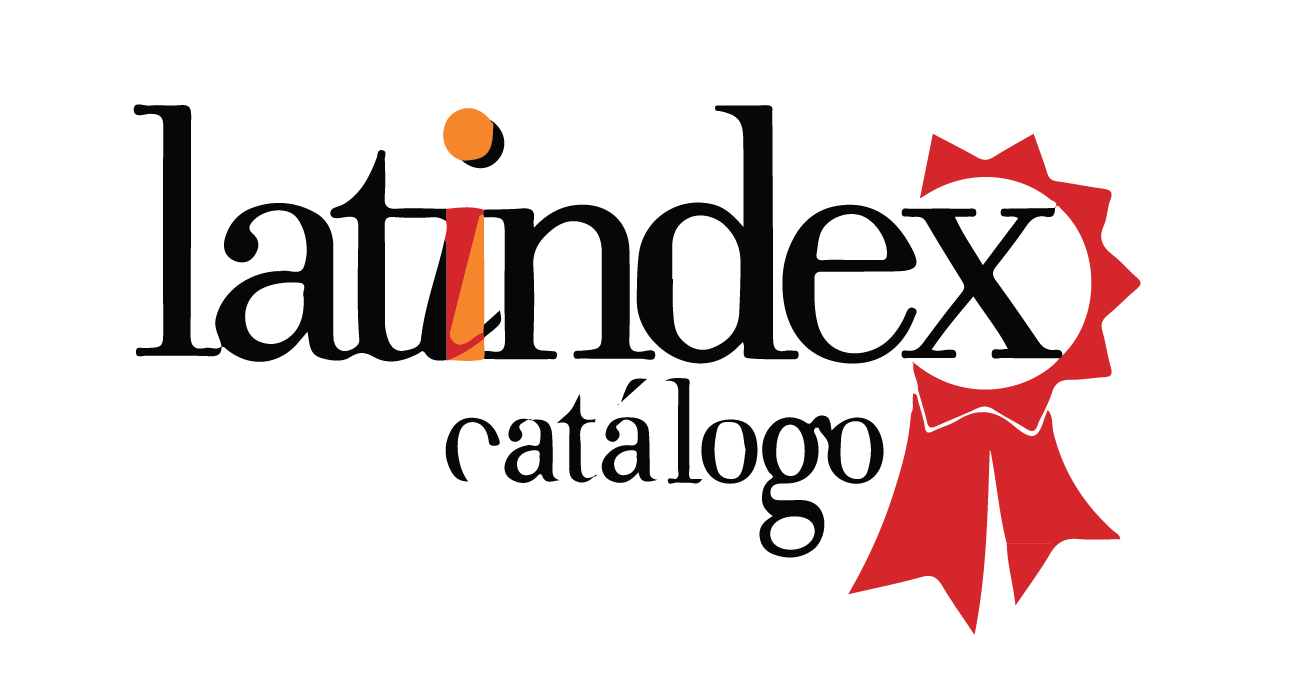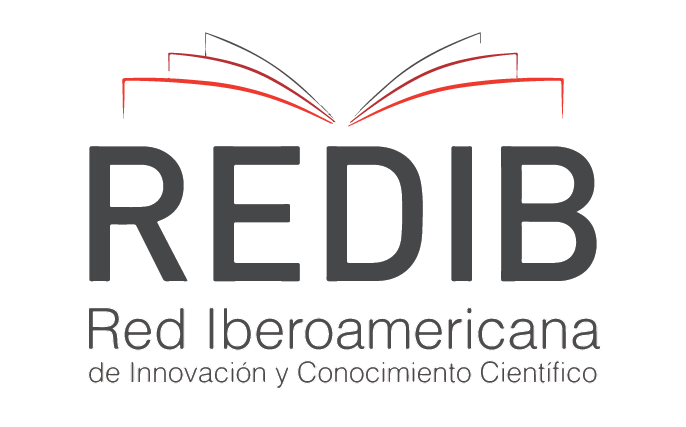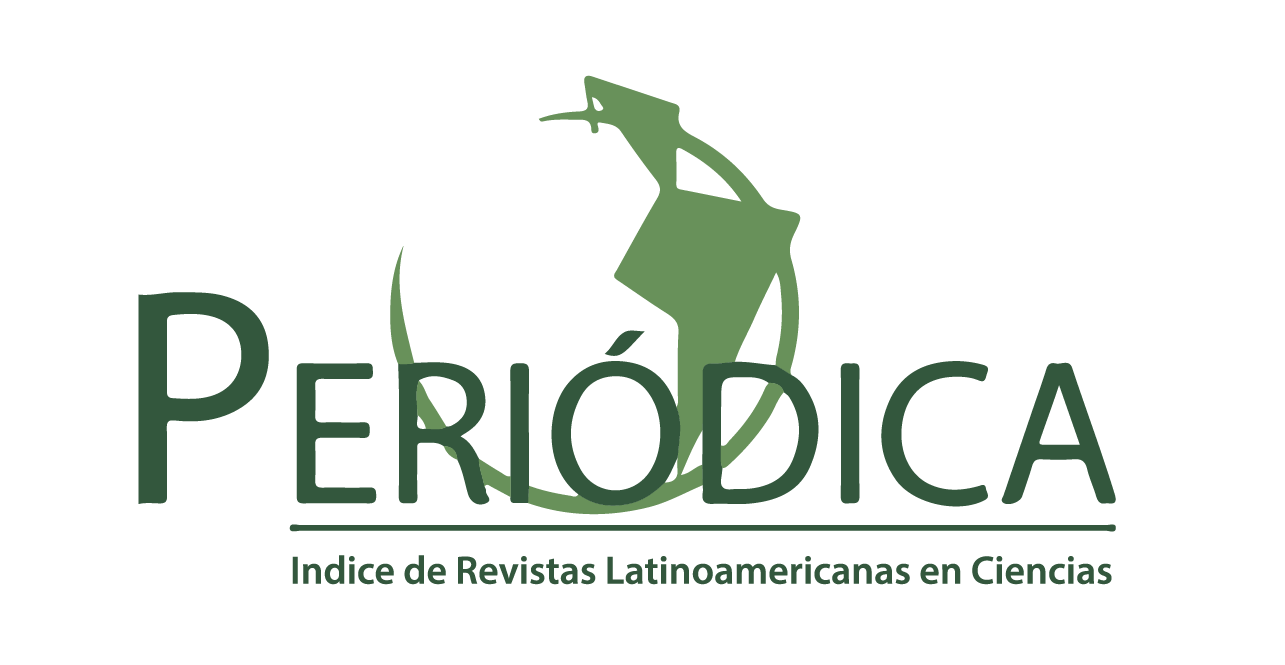INTEGRACIÓN MORFOLÓGICA DE LA MANDÍBULA DE LOS UNGULADOS NATIVOS DE AMÉRICA DEL SUR. UN TRIBUTO A D’ARCY THOMPSON EN EL CENTENARIO DE “SOBRE EL CRECIMIENTO Y LA FORMA”
DOI:
https://doi.org/10.5710/PEAPA.07.12.2017.253Palabras clave:
Notoungulata, Litopterna, Santacrucense, Morfometría Geométrica, D’Arcy Thompson, ModularidadResumen
Los ungulados nativos de América del Sur incluyen varios linajes extintos que evolucionaron en el contexto de aislamiento geográfico del Cenozoico sudamericano. Durante el Santacrucense (Mioceno temprano), los órdenes Notoungulata, Litopterna y Astrapotheria ya estaban diferenciados. Los estudios ecomorfológicos recientes destacaron patrones funcionales complejos entre hábitat/dieta e hipsodoncia en estos grupos. Se analizan estas relaciones en un contexto evolutivo, utilizando métodos morfogeométricos (27 landmarks 3-D) para evaluar la integración morfológica de dos de las unidades funcionales principales de la mandíbula: región alveolar y rama ascendente. Para explorar los patrones de variación y covariación entre estos dos módulos, se utilizaron Análisis de componentes principales (PCA) y Análisis de mínimos cuadrados parciales de dos bloques (PLS). La variación principal de forma está relacionada con la robustez y la curvatura del cuerpo mandibular y el tamaño relativo de los procesos angular y coronoides. Los PLS muestran una integración morfológica muy fuerte en Litopterna y un patrón de modularidad en Notoungulata. Existe un patrón común de covariación en Astrapotheria y Litopterna que podría deberse a restricciones similares. Los diferentes patrones de covariación en notoungulados con respecto a los litopternos están en concordancia con la diversidad taxonómica y morfológica de los clados, particularmente en los tipoterios. La modularidad presente en Notoungulata habría permitido especializaciones en cada módulo de la mandíbula, relacionadas con la altura de la corona o las inserciones musculares, sin una alta restricción morfológica. Esto podría haber resultado en su alta diversidad morfológica, en contraste con la morfología más conservadora presente en Litopterna.
Citas
Adams, D.C., Rohlf, F.J. and Slice, D.E. 2013. A field comes of age: geometric morphometrics in the 21st century. Hystrix 24: 8.
Ameghino, F. 1887a. Enumeración sistemática de las especies de mamíferos fósiles coleccionados por Carlos Ameghino en los terrenos eocenos de la Patagonia austral y depositados en el Museo La Plata. Boletín del Museo La Plata 1: 1-26.
Ameghino, F. 1887b. Observaciones generales sobre el órden de mamíferos estinguidos sub-americanos llamados Toxodontes (Toxodontia) y sinópsis de los géneros y especies hasta ahora conocidos. Anales del Museo de La Plata 1: 1-66.
Ameghino, F. 1894. Enumération synoptique des espèces de mammifères fossiles des formations éocènes de Patagonie. Boletín de la Academia Nacional de Ciencias de Córdoba 13: 259-445.
Bargo, M.S. and Vizcaíno, S.F. 2008. Paleobiology of Pleistocene ground sloths (Xenarthra, Tardigrada): biomechanics, morphogeometry and ecomorphology applied to the masticatory apparatus. Ameghiniana 45: 175-196.
Bastir, M., Rosas, A., Stringer, C., Manuel Cuétara, J., Kruszynski, R., Weber, G.W., Ross, C.F. and Ravosa, M.J. 2010. Effects of brain and facial size on basicranial form in human and primate evolution. Journal of Human Evolution 58: 424-431.
Billet, G., Blondel, C. and de Muizon, C. 2009. Dental microwear analysis of notoungulates (Mammalia) from Salla (Late Oligocene, Bolivia) and discussion on their precocious hypsodonty. Palaeogeography, Palaeoclimatology, Palaeoecology 274: 114-124.
Billet, G. 2010. New Observations on the Skull of Pyrotherium (Pyrotheria, Mammalia) and New Phylogenetic Hypotheses on South American Ungulates. Journal of Mammalian Evolution 17: 21-59.
Billet, G. 2011. Phylogeny of the Notoungulata (Mammalia) based on cranial and dental characters. Journal of Systematic Palaeontology 9: 481-497.
Burmeister, C.G. 1879. Description physique de la République Argentine d´après des observations personnelles et étrangères, Imprenta Paul-Émile Coni Buenos Aires, pp.
Burmeister, C.G. 1885. Examen crítico de los mamíferos y reptiles fósiles denominados por D. Augusto Bravard y mencionados en su obra precedente. Anales del Museo Nacional de Historia Natural de Buenos Aires 3: 95-174.
Cardini, A. and Loy, A. 2013. On growth and form in the "computer era": from geometric to biological morphometrics. Hystrix 24: 5.
Cassini, G.H., Mendoza, M., Vizcaíno, S.F. and Bargo, M.S. 2011. Inferring habitat and feeding behaviour of early Miocene notoungulates from Patagonia. Lethaia 44: 153-165.
Cassini, G.H., Cerdeño, M.E., Villafañe, A.L. and Muñoz, N.A. 2012a. Paleobiology of Santacrucian native ungulates (Meridiungulata: Astrapotheria, Litopterna and Notoungulata. In: Vizcaíno, S.F., Kay, R. and
Bargo, M.S. (Eds.), Early Miocene Paleobiology in Patagonia: high-latitude paleocommunities of the Santa Cruz Formation, Cambridge University Press, pp. 243-286.
Cassini, G.H. and Vizcaíno, S.F. 2012. An Approach to the Biomechanics of the Masticatory Apparatus of Early Miocene (Santacrucian Age) South American Ungulates (Astrapotheria, Litopterna, and Notoungulata): Moment Arm Estimation Based on 3D Landmarks. Journal of Mammalian Evolution 19: 9-25.
Cassini, G.H., Vizcaíno, S.F. and Bargo, M.S. 2012b. Body mass estimation in Early Miocene native South American ungulates: a predictive equation based on 3D landmarks. Journal of Zoology 287: 53-64.
Cassini, G.H. 2013. Skull geometric morphometrics and paleoecology of Santacrucian (late early Miocene; Patagonia) native ungulates (Astrapotheria, Litopterna, and Notoungulata). Ameghiniana 50: 193-216.
Cassini, G.H., Hernández Del Pino, S., Muñoz, N.A., Acosta, M.V.W.G., Fernández, M., Bargo, M.S. and Vizcaíno, S.F. 2017. Teeth complexity, hypsodonty and body mass in Santacrucian (Early Miocene) notoungulates (Mammalia). Earth and Environmental Science Transactions of the Royal Society of Edinburgh 106: 303-313.
Cifelli, R.L. and Guerrero, J.G. 1997. Litopterns. In: Kay, R.F., Madden, R.H., Cifelli, R.L. and Flynn, J.J. (Eds.), Vertebrate Paleontology in the Neotropics: The Miocene Fauna of La Venta, Colombia, Smithsonian Institution Press, Washington, DC, pp. 289-302.
Croft, D.A. 1999. Placentals: endemic South American ungulates. In The Encyclopedia of Paleontology. ed. Singer, R. Chicago, Fitzroy-Dearborn.
Croft, D.A. 2001. Cenozoic environmental change in South America as indicated by mammalian body size distributions (cenograms). Diversity and Distributions 7: 271-287.
Croft, D.A. and Anderson, L.C. 2008. Locomotion in the extinct notoungulate Protypotherium. Palaeontologia Electronica 11: 1-20.
Croft, D.A. and Weinstein, D. 2008. The first application of the mesowear method to endemic South American ungulates (Notoungulata). Palaeogeography, Palaeoclimatology, Palaeoecology 269: 103-114.
Darwin, C. 1845. The voyage of the Beagle. Journal of researches into the natural history and geology of the countries visited during the voyage of H.M.S. Beagle around the world, under the command of Capt. Fitz Roy, R.A., Murray London, 536 pp.
De Esteban-Trivigno, S. 2011. Ecomorfología de Xenartros extintos: análisis de la mandíbula con métodos de morfometría geométrica. Ameghiniana 48: 381-398.
Drake, Abby G. and Klingenberg, Christian P. 2010. Large-Scale Diversification of Skull Shape in Domestic Dogs: Disparity and Modularity. The American Naturalist 175: 289-301.
Elissamburu, A. 2004. Análisis morfométrico y morfofuncional del esqueleto apendicular de Paedotherium (Mammalia, Notoungulata). Ameghiniana 41: 363-380.
Elissamburu, A. 2010. Estudio biomecánico y morfofuncional del esqueleto apendicular de Homalodotherium Flower 1873 (Mammalia, Notoungulata). Ameghiniana 47: 25-43.
Elissamburu, A. 2012. Estimación de la masa corporal en géneros del Orden Notoungulata. Estudios Geológicos 68.
Fraser, D. and Theodor, J.M. 2011. Comparing ungulate dietary proxies using discriminant function analysis. Journal of Morphology 272: 1513-1526.
Giannini, N.P. and García-López, D.A. 2014. Ecomorphology of Mammalian Fossil Lineages: Identifying Morphotypes in a Case Study of Endemic South American Ungulates. Journal of Mammalian Evolution 21: 195-212.
Gomes Rodrigues, H., Herrel, A. and Billet, G. 2017. Ontogenetic and life history trait changes associated with convergent ecological specializations in extinct ungulate mammals. Proceedings of the National Academy of Sciences 114: 1069-1074.
Janis, C.M. 1995. Correlations between craniodental morphology and feeding behavior in ungulates: Reciprocal illumination between living and fossil taxa. In: Thomason, J.J. (Ed.) Functional Morphology in Vertebrate Paleontology, Cambridge University Press, Cambridge, pp. 76-98.
Klingenberg, C.P. and Zaklan, S.D. 2000. Morphological integration between developmental compartiments in the Drosophila wing. Evolution 54: 1273-1285.
Klingenberg, C.P., Mebus, K. and Auffray, J.-C. 2003. Developmental integration in a complex morphological structure: how distinct are the modules in the mouse mandible? Evolution & Development 5: 522-531.
Klingenberg, C.P. 2008. Morphological Integration and Developmental Modularity. Annual Review of Ecology, Evolution, and Systematics 39: 115-132.
Klingenberg, C.P. 2009. Morphometric integration and modularity in configurations of landmarks: tools for evaluating a priori hypotheses. Evolution & Development 11: 405-421.
Klingenberg, C.P. 2011. MorphoJ: an integrated software package for geometric morphometrics. Molecular Ecology Resources 11: 353-357.
Klingenberg, C.P. 2013. Cranial integration and modularity: insights into evolution and development from morphometric data. Hystrix 24: 16.
Klingenberg, C.P. and Marugán-Lobón, J. 2013. Evolutionary Covariation in Geometric Morphometric Data: Analyzing Integration, Modularity, and Allometry in a Phylogenetic Context. Systematic Biology 62: 591-610.
Maddison, W.P. 1991. Squared-Change Parsimony Reconstructions of Ancestral States for Continuous-Valued Characters on a Phylogenetic Tree. Systematic Biology 40: 304-314.
Mayr, E. 1982. The growth of biological thought: Diversity, evolution, and inheritance, Harvard University Press Cambridge, pp.
Mendoza, M. and Palmqvist, P. 2008. Hypsodonty in ungulates: An adaptation for grass consumption or for foraging in open habitat? Journal of Zoology 274: 134-142.
Mitteroecker, P. and Bookstein, F. 2008. The evolutionary role of modularity and integration in the hominoid cranium. Evolution 62: 943-958.
Mones, A. 1982. An equivocal nomenclature: What means hypsodonty? Paläontologische Zeitschrift 56: 107-111.
Muñoz, N.A., Cassini, G.H., Candela, A.M. and Vizcaíno, S.F. 2017. Ulnar articular surface 3-D landmarks and ecomorphology of small mammals: a case study of two early Miocene typotheres (Notoungulata) from Patagonia. Earth and Environmental Science Transactions of the Royal Society of Edinburgh 106: 315-323.
Nasif, N.L., Musalem, S. and Cerdeño, E. 2000. A new toxodont from the late Miocene of Catamarca, Argentina, and a phylogenetic analysis of the Toxodontidae. Journal of Vertebrate Paleontology 20: 591-600.
Oksanen, J., Blanchet, F.G., Friendly, M., Kindt, R., Legendre, P., McGlinn, D., Minchin, P.R., O'Hara, R.B., Simpson, G.L., Solymos, P., Stevens, M.H.H., Szoecs, E. and Wagner, H. 2017. vegan: Community Ecology Package. 2.4-3 edn.
Owen, R. 1846. Notices of some fossil mammalia of South America. British Association for the Advancement of Science, report 1846, transactions of the sections 16: 65–67.
R Development Core Team 2017. R: A language and environment for statistical computing., R Foundation for Statistical Computing Vienna, Austria, pp.
Reddy, D.P., Kim, J. and Raaum, R. 2007. Resample.exe. http://pages.nycep.org/nmg/programs.html.
Reguero, M.A. and Prevosti, F.J. 2010. Rodent-like notoungulates (Typotheria) from Gran Barranca, Chubut Province, Argentina: phylogeny and systematics. In: Madden, R.H., Carlini, A.A., Vucetich, M.G. and Kay, R.F. (Eds.), The Paleontology of Gran Barranca: Evolution and Environmental Change through the Middle Cenozoic of Patagonia, Cambridge University Press, pp. 148-165.
Rensberger, J.M. and Pfretzschner, H.U. 1992. Enamel structure in astrapotheres and its functional implications. Scanning Microscopy 6: 495–510.
Riggs, E.S. 1935. A skeleton of Astrapotherium. Geological series of Field Museum of Natural History 6: 167-177.
Rohlf, F.J. 1990. Rotational fit (Procrustes) methods. In: Rohlf, F.J. and Bookstein, F.L. (Eds.), Proocedings of the Michigan Morphometrics Workshop, University of Michigan Museum of Zoology, Special Publication Nº 2, Michigan pp. 227-236.
Scarano, A.C., Carlini, A.A. and Illius, A.W. 2011. Interatheriidae (Typotheria: Notoungulata), body size and paleoecology characterization. Mammalian Biology 76: 109-1114.
Scott, W.B. 1910. Mammalia of the Santa Cruz beds. Part I. Litopterna. In Reports of the Princeton University Expeditions to Patagonia, 1896-1899. ed. Scott, W.B. Princeton, Princeton University.
Scott, W.B. 1937. A history of land mammals in the Western Hemisphere, Macmillan New York, 786 pp.
Schlager, S. 2017. Morpho and Rvcg - Shape Analysis in R. In: Zheng, G., Li, S. and Szekely, G. (Eds.), Statistical Shape and Deformation
Analysis, Academic Press, London, UK, pp. 217-256.
Schmidt, G.I. 2015. Actualización sistemática y filogenia de los Proterotheriidae (Mammalia, Litopterna) del “Mesopotamiense”(Mioceno tardío) de Entre Ríos, Argentina. Revista Brasileira de Paleontología 18: 3.
Soria, M.F. 2001. Los Proterotheriidae (Litopterna, Mammalia), sitemática, origen y filogenia. Monografías del Museo Argentino de Ciencias Naturales 1: 1-167.
Thompson, D.A.W. 1917. On growth and form. Cambrige Cambrige University Press.
Townsend, K.E.B. and Croft, D.A. 2008. Diets of notoungulates from the Santa Cruz Formation, Argentina: New evidence from enamel microwear. Journal of Vertebrate Paleontology 28: 217-230.
Villafañe, A.L., Ortiz-Jaureguizar, E. and Bond, M. 2006. Cambios en la riqueza taxonómica y en las tasas de primera y última aparición de los Proterotheriidae (Mammalia, Litopterna) durante el Cenozoico. Estudios Geológicos 62: 155-166.
Vizcaíno, S.F. and Bargo, M.S. 1998. The masticatory apparatus of Eutatus (Mammalia, Cingulata) and some allied genera. Evolution and paleobiology. Paleobiology 24: 371-383.
Vizcaíno, S.F., Bargo, M.S., Kay, R.F., Fariña, R.A., Di Giacomo, M., Perry, J.M.G., Prevosti, F.J., Toledo, N., Cassini, G.H. and Fernicola, J.C. 2010. A baseline paleoecological study for the Santa Cruz Formation (late–early Miocene) at the Atlantic coast of Patagonia, Argentina. Palaeogeography, Palaeoclimatology, Palaeoecology 292: 507-519.
Vizcaíno, S.F., Kay, R. and Bargo, M.S. 2012. Early Miocene Paleobiology in Patagonia: high-latitude paleocommunities of the Santa Cruz Formation, Cambridge University Press Cambridge, pp.
Vizcaíno, S.F., Bargo, M.S., Cassini, G.H. and Toledo, N. 2016. Forma y función en paleobiología de vertebrados, Editorial de la Universidad Nacional de La Plata (EDULP), 268-268 pp.
Welker, F., Collins, M.J., Thomas, J.A., Wadsley, M., Brace, S., Cappellini, E., Turvey, S.T., Reguero, M., Gelfo, J.N., Kramarz, A., Burger, J., Thomas-Oates, J., Ashford, D.A., Ashton, P.D., Rowsell, K., Porter, D.M., Kessler, B., Fischer, R., Baessmann, C., Kaspar, S., Olsen, J.V., Kiley, P., Elliott, J.A., Kelstrup, C.D., Mullin, V., Hofreiter, M., Willerslev, E., Hublin, J.-J., Orlando, L., Barnes, I. and MacPhee, R.D.E. 2015. Ancient proteins resolve the evolutionary history of Darwin's South American ungulates. Nature 522: 81-84.

Descargas
Publicado
Número
Sección
Licencia
Derechos de autor 2017 Publicación Electrónica de la Asociación Paleontológica Argentina

Esta obra está bajo una licencia internacional Creative Commons Atribución-SinDerivadas 4.0.

Los/las autores/as conservan los derechos de autor/a y garantizan a la revista el derecho de ser la primera publicación del trabajo licenciado bajo una licencia CC Attribution-NonCommercial 4.0 que permite a otros/as compartir el trabajo con el reconocimiento de la autoría y de la publicación inicial en esta revista.







